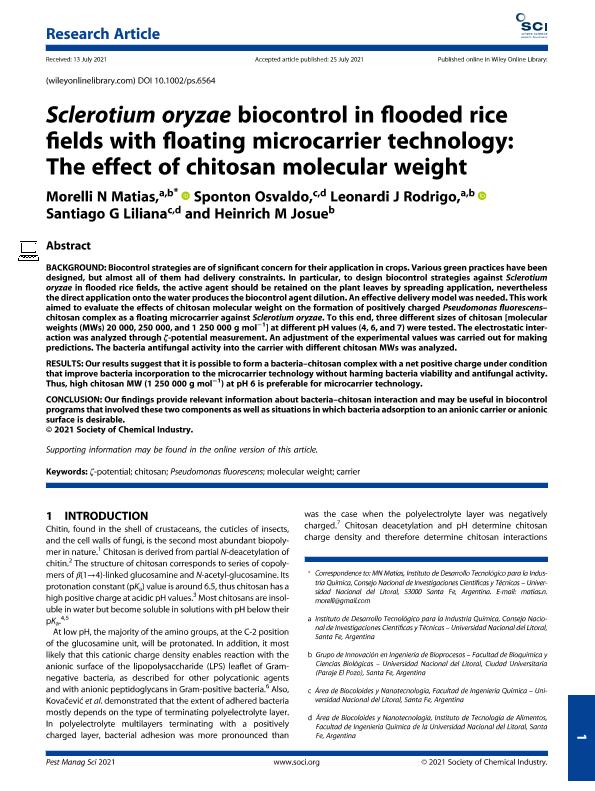Mostrar el registro sencillo del ítem
dc.contributor.author
Morelli, Matias Nicolas

dc.contributor.author
Sponton, Osvaldo Ernesto

dc.contributor.author
Leonardi, Rodrigo Jorge

dc.contributor.author
Santiago, Liliana G.

dc.contributor.author
Heinrich, Josué Miguel

dc.date.available
2022-08-11T12:08:29Z
dc.date.issued
2021-07
dc.identifier.citation
Morelli, Matias Nicolas; Sponton, Osvaldo Ernesto; Leonardi, Rodrigo Jorge; Santiago, Liliana G.; Heinrich, Josué Miguel; Sclerotium oryzae biocontrol in flooded rice fields with floating microcarrier technology: The effect of chitosan molecular weight; John Wiley & Sons Ltd; Pest Management Science; 77; 11; 7-2021; 5228-5235
dc.identifier.issn
1526-498X
dc.identifier.uri
http://hdl.handle.net/11336/165115
dc.description.abstract
BACKGROUND: Biocontrol strategies are of significant concern for their application in crops. Various green practices have been designed, but almost all of them had delivery constraints. In particular, to design biocontrol strategies against Sclerotium oryzae in flooded rice fields, the active agent should be retained on the plant leaves by spreading application, nevertheless the direct application onto the water produces the biocontrol agent dilution. An effective delivery model was needed. This work aimed to evaluate the effects of chitosan molecular weight on the formation of positively charged Pseudomonas fluorescens–chitosan complex as a floating microcarrier against Sclerotium oryzae. To this end, three different sizes of chitosan [molecular weights (MWs) 20 000, 250 000, and 1 250 000 g mol−1] at different pH values (4, 6, and 7) were tested. The electrostatic interaction was analyzed through ζ-potential measurement. An adjustment of the experimental values was carried out for making predictions. The bacteria antifungal activity into the carrier with different chitosan MWs was analyzed. RESULTS: Our results suggest that it is possible to form a bacteria–chitosan complex with a net positive charge under condition that improve bacteria incorporation to the microcarrier technology without harming bacteria viability and antifungal activity. Thus, high chitosan MW (1 250 000 g mol−1) at pH 6 is preferable for microcarrier technology. CONCLUSION: Our findings provide relevant information about bacteria–chitosan interaction and may be useful in biocontrol programs that involved these two components as well as situations in which bacteria adsorption to an anionic carrier or anionic surface is desirable.
dc.format
application/pdf
dc.language.iso
eng
dc.publisher
John Wiley & Sons Ltd

dc.rights
info:eu-repo/semantics/openAccess
dc.rights.uri
https://creativecommons.org/licenses/by-nc-sa/2.5/ar/
dc.subject
CARRIER
dc.subject
CHITOSAN
dc.subject
MOLECULAR WEIGHT
dc.subject
PSEUDOMONAS FLUORESCENS
dc.subject
Ζ-POTENTIAL
dc.subject.classification
Otras Biotecnología del Medio Ambiente

dc.subject.classification
Biotecnología del Medio Ambiente

dc.subject.classification
INGENIERÍAS Y TECNOLOGÍAS

dc.title
Sclerotium oryzae biocontrol in flooded rice fields with floating microcarrier technology: The effect of chitosan molecular weight
dc.type
info:eu-repo/semantics/article
dc.type
info:ar-repo/semantics/artículo
dc.type
info:eu-repo/semantics/publishedVersion
dc.date.updated
2022-08-08T15:16:08Z
dc.journal.volume
77
dc.journal.number
11
dc.journal.pagination
5228-5235
dc.journal.pais
Reino Unido

dc.description.fil
Fil: Morelli, Matias Nicolas. Consejo Nacional de Investigaciones Científicas y Técnicas. Centro Científico Tecnológico Conicet - Santa Fe. Instituto de Desarrollo Tecnológico para la Industria Química. Universidad Nacional del Litoral. Instituto de Desarrollo Tecnológico para la Industria Química; Argentina
dc.description.fil
Fil: Sponton, Osvaldo Ernesto. Universidad Nacional del Litoral. Facultad de Ingeniería Química; Argentina. Universidad Nacional del Litoral. Facultad de Ingeniería Química. Instituto de Tecnología de los Alimentos; Argentina. Consejo Nacional de Investigaciones Científicas y Técnicas. Centro Científico Tecnológico Conicet - Santa Fe; Argentina
dc.description.fil
Fil: Leonardi, Rodrigo Jorge. Consejo Nacional de Investigaciones Científicas y Técnicas. Centro Científico Tecnológico Conicet - Santa Fe. Instituto de Desarrollo Tecnológico para la Industria Química. Universidad Nacional del Litoral. Instituto de Desarrollo Tecnológico para la Industria Química; Argentina
dc.description.fil
Fil: Santiago, Liliana G.. Universidad Nacional del Litoral. Facultad de Ingeniería Química; Argentina. Universidad Nacional del Litoral. Facultad de Ingeniería Química. Instituto de Tecnología de los Alimentos; Argentina
dc.description.fil
Fil: Heinrich, Josué Miguel. Universidad Nacional del Litoral. Facultad de Ingeniería Química; Argentina. Consejo Nacional de Investigaciones Científicas y Técnicas. Centro Científico Tecnológico Conicet - Santa Fe; Argentina
dc.journal.title
Pest Management Science

dc.relation.alternativeid
info:eu-repo/semantics/altIdentifier/url/https://onlinelibrary.wiley.com/doi/10.1002/ps.6564
dc.relation.alternativeid
info:eu-repo/semantics/altIdentifier/doi/http://dx.doi.org/10.1002/ps.6564
Archivos asociados
